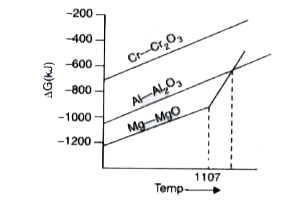Suggest a condition unders which magnesium could reduce alumina.
To determine the conditions under which magnesium can reduce alumina (Al2O3), we can follow these steps:
Step 1: Understanding the Reaction
Alumina (Al2O3) is a compound of aluminum and oxygen. To reduce alumina, we need a reducing agent that can donate electrons to aluminum ions in the alumina. In this case, magnesium (Mg) can serve as a reducing agent.
Step 2: Writing the Reaction
The reduction reaction can be represented as:
Al2O3+3Mg→2Al+3MgO
This equation shows that magnesium reacts with alumina to produce aluminum and magnesium oxide.
Step 3: Identifying the Condition
The reduction of alumina by magnesium is thermodynamically favorable under certain conditions. Specifically, the reaction is favored at high temperatures. The Gibbs free energy change (ΔG) for the reaction must be negative for the reaction to occur spontaneously.
Step 4: Conclusion
Thus, magnesium can effectively reduce alumina when subjected to high temperatures, typically above 1000°C. This is because at elevated temperatures, the Gibbs free energy becomes more negative, favoring the reduction process.
Final Answer
Magnesium can reduce alumina (Al2O3) at high temperatures, typically above 1000°C.
---
Alumina (Al2O3) is a compound of aluminum and oxygen. To reduce alumina, we need a reducing agent that can donate electrons to aluminum ions in the alumina. In this case, magnesium (Mg) can serve as a reducing agent.
The reduction reaction can be represented as:
Al2O3+3Mg→2Al+3MgO
This equation shows that magnesium reacts with alumina to produce aluminum and magnesium oxide.
The reduction of alumina by magnesium is thermodynamically favorable under certain conditions. Specifically, the reaction is favored at high temperatures. The Gibbs free energy change (ΔG) for the reaction must be negative for the reaction to occur spontaneously.
Thus, magnesium can effectively reduce alumina when subjected to high temperatures, typically above 1000°C. This is because at elevated temperatures, the Gibbs free energy becomes more negative, favoring the reduction process.
Magnesium can reduce alumina (Al2O3) at high temperatures, typically above 1000°C.
Topper's Solved these Questions
- BOOK - PRADEEPCHAPTER - GENERAL PRINCIPLES AND PROCESSES OF ISOLATION OF ELEMENTS EXERCISE - NCERT QUESTIONS AND EXERCISES WITH ANSWERS (NCERT INTEXT UNSOLVED QUESTIONS)4videos
GENERAL PRINCIPLES AND PROCESSES OF ISOLATION OF ELEMENTS
- BOOK - PRADEEPCHAPTER - GENERAL PRINCIPLES AND PROCESSES OF ISOLATION OF ELEMENTS EXERCISE - NCERT QUESTIONS AND EXERCISES WITH ANSWERS (NCERT EXERCISES)27videos
GENERAL PRINCIPLES AND PROCESSES OF ISOLATION OF ELEMENTS
- BOOK - PRADEEPCHAPTER - GENERAL PRINCIPLES AND PROCESSES OF ISOLATION OF ELEMENTS EXERCISE - CONCEPTUAL QUESTIONS14videos
GENERAL PRINCIPLES AND PROCESSES OF ISOLATION OF ELEMENTS
- BOOK - PRADEEPCHAPTER - ELECTROCHEMISTRYEXERCISE - IMPORTANT QUESTIONS FOR BOARD EXAMINATION25videos
ELECTROCHEMISTRY
- BOOK - PRADEEPCHAPTER - HALOALKANES AND HALOARENESEXERCISE - IMPORTANT QUESTIONS FOR BOARD EXAMINATION22videos
HALOALKANES AND HALOARENES
Similar Questions
(a) Suggest a condition under which magnesium could reduce alumina.
(b) Although thermodynamically feasible, in practice magnesium metal is not used for the reduction of alumina in the metallurgy of aluminium. Why ?
( c) What is the reduction of a metal oxide easier if the metal formed is in liquid state at the temperature of reduction ?
(d) At a site, low grade copper ores oare available and zinc and iron scraps are also available. Which of the two scraps would be more suitable for reducing the leached copper ore and why ?View SolutionA part of Ellingham diagram is shown below :

(i) Will Cr2O3 be reduced by Al or not ?
(ii) Suggest a condition under which magnesium could reduced aluminium.View Solution
Knowledge Check
- Question 1 - Select One
The conditions under which transpiration would be most rapid
AHigh humidityBExcess of water in soilCLow humidity, high temperture, guard cells are turgid (open) and moist soilDLow veloctiy of wind - Question 2 - Select One
The conditions under which transpiration would be most rapid are
AExcess of water in soilBLow humidity , high temperature , turgid guard cells and moist soilCLow velocity of windDHigh humidity
Predict conditions under which Al might be expected to reduce MgO.
View SolutionPredict conditions under which Al might be expected to reduce MgO.
View SolutionExplain the conditions under which a mirage is seen.
View SolutionState the conditions under which a force does no work.?
View SolutionThe under certain conditions magnesium can be reduce SiO2 and silicon can reduce MgO. What are those conditions?
View SolutionIt is true that under certain coditions magnesium can reduce SiO2 and silicon can reduce MgO. What are those conditions ?
View Solution

